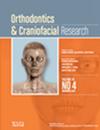Influence of Different Preactivation Patterns and Aligner Materials on the Capability of Aligners to Induce Palatal Root Torque of Upper Incisors: An In Vitro Biomechanical Study
Abstract
Objectives
Previous studies have demonstrated that aligners with labial-cervical pressure points can induce root movement, but with initial unwanted tipping. This study assessed the impact of palatal-incisal pressure points on improving root movement and reducing initial offset. Additionally, the influence of aligner materials on force and moment generation was evaluated.
Material and Methods
The experimental setup consisted of an acrylic upper jaw model with teeth 11 and 21 separated and secured to a Hexapod using a 3D force-moment sensor, allowing for the simulation of various malpositions of the measurement teeth. In addition to labial pressure points set close to the cervical margins at a depth of 1.5 mm, we investigated palatal pressure points positioned close to the incisal edge at depths ranging from 0.1 to 0.9 mm. We evaluated the force/moment (F/M) systems generated by both mono- and multi-layered aligner materials during the simulated correction of 2° retroinclination of the measurement teeth. Five aligners were tested for each configuration. The relevant palatal torque range (palTR) was identified when the aligners simultaneously induced a negative palatal force (−Fy) and a negative palatal torque moment (−Mx).
Results
PET-G aligners without pressure points showed no effective torque range. In contrast, aligners with pressure points generated an effective torque range of an average of 1.02° ± 0.03° following initial tooth tipping. The palatal-incisal pressure points showed a significant reduction or elimination of the initial offset. Our findings revealed a general correlation between palTR-start displacement (initial offset range) and palatal pressure point depth (linear mixed-effects models, p < 0.05). In this manner, the initial offset for the 0.6 mm pressure points was reduced by 81.1% compared to that of the unmodified aligners (from 1.57° to 0.3°).
Conclusion
The addition of palatal-incisal pressure points alongside labial-cervical pressure points demonstrated a promising reduction in the initial offset range in an in vitro setting, potentially enhancing the efficiency of torque movement with aligners. However, further biomechanical and clinical studies are necessary for the clinical translation of these results.


 求助内容:
求助内容: 应助结果提醒方式:
应助结果提醒方式:


